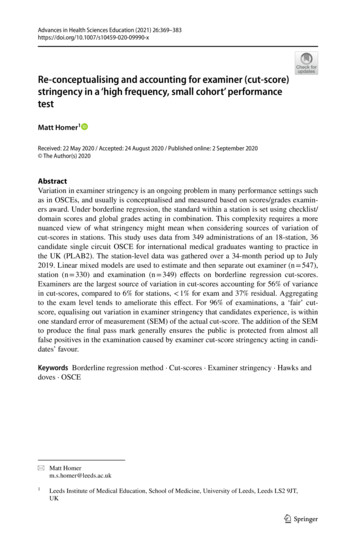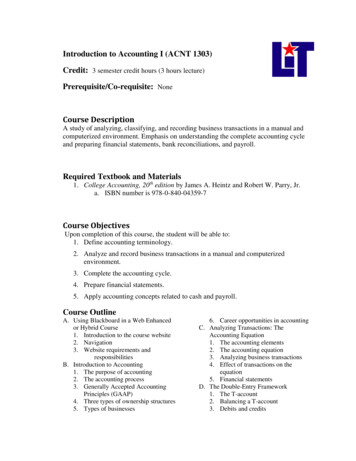
Transcription
, an issue we will return to at relevant points in the paper.Table 2 summarises the frequency of each facet considered in this analysis (examiner,station, examination).13
M. Homer374We see, for example, that across the 6214 stations administrations, there were 547 different examiners and 330 different stations. It is also clear from Table 2 that both individual examiners, and stations, are present in the data in varying degrees, but that typicallythere are multiple data points for each level of each facet—median 6 and 17 for examinerand station respectively. This gives us some confidence that there is sufficient data to estimate effects on cut-scores with some degree of precision.Table 2 also shows that on occasion individual stations were supressed from theintended 18 station OSCE—the mean no. of stations per exam is 17.81 (i.e. less than18). These stations were removed from the examination—usually, because of problemsobserved during the examination which meant the pattern of scores/grades were deemedinsufficiently reliable for use in this high-stakes setting (Pell et al. 2010).The exact nature of the calculation of the station-level cut-score using BRM has beenmodified in PLAB2 over the course of the period 2016–2019. In more recent years, thex-value used to create the pass mark has been increased a little above the usual ‘borderline’value of 1 (see Fig. 1) increasing cut-scores. However, to keep all the data directly comparable we have consistently used the original approach to BRM in all that follows. Actualcut-scores in PLAB2 are typically higher than those shown in this work. This issue doesnot effect in any way the substantive findings presented.This study does not directly employ candidate scores—these were not available foranalysis. In extant work on examiner stringency (McManus et al. 2006) candidate variation is often found to be the main influence on scores—as one would hope in any validassessment. However, at least in principle, when criterion-based standard setting is applied,cut-scores should not be directly dependent on the group of candidates sitting an examination, or indeed on other factors such as time of day. The standard is formulated in termsof the hypothetical borderline, or minimally competent, candidate (McKinley and Norcini2014). Obviously, in practice outcomes of BRM and other examinee-centred approaches dodepend on candidate scores (Pell et al. 2010).Methods of analysisWe use simple graphical approaches to visualise key variables/relationships (e.g. histograms and error bars). Our main method of analysis is linear mixed effect modelling usingthe R package lme4 (Bates et al. 2015) (via the function lmer) to estimate the individualeffect of each facet in Table 2 on station-level cut-scores.We begin by analysing individual effects of each facet on cut-scores in three separatesimple models (one for each of examiner, station and examination). We then create a combined model for cut-scores including all three of these facets to take account of the fact thateach examiner ‘sees’ a potentially unique set of stations, and vice versa.The formal equation for the combined model is as follows:(Cut score)ijk 𝛽0 examineri stationj examinationK 𝜀ijkwhere (Cut score)ijk is the cut-score corresponding to examiner i, station j and examination k (i 1, 547; j 1, ,330; k 1, ,349); 𝛽0 is the grand mean cut-score; examineri ,stationj and examinationK are the random effects of examiner, station and examinationrespectively on cut-scores (assumed normally distributed); and 𝜀ijk is the normally distributed error term.In each of these models, each facet is treated as a random effect. In other words, we aretreating the examiners in the sample as representative of the hypothetical universe of all13
Re-conceptualising and accounting for examiner (cut-score) 375potential examiners. Similarly for stations, and examinations. The model then calculatesvariance components for each random effect, which tell us how
skills to begin practising medicine in the UK (General Medical Council 2020b) at the level equivalent to that at the end of the rst year of Foundation Training (i.e. rst year of clini-cal practice). There are two parts to the PLAB test, an applied knowledge test (PLAB1) and an 18 station OSCE (PLAB2).











